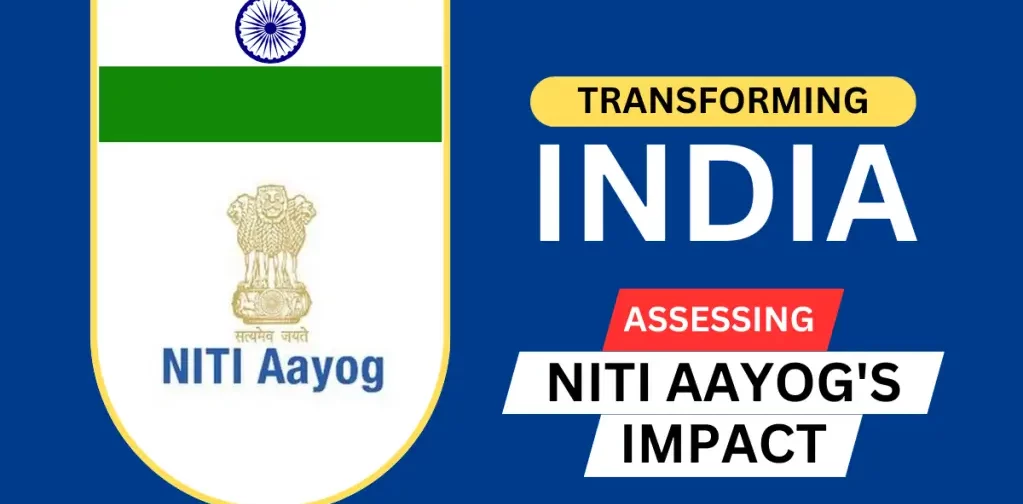
- Home
- About
- Knowledge Center
- Legislative Landscape
- Resources
- #TOGETHERFORBHARA
The term “NITI” is a Sanskrit word that means morality, behavior, or guidance. In the context of policy, it is an acronym for “National Institution for Transforming India.” It functions as a think tank and government advisory agency. Regarding issues involving strategic policy for the Union and the States, it offers recommendations to the government. In addition, it covers economic concerns of relevance both domestically and globally.
The Union Government announced the formation of the NITI Aayog on January 1, 2015. The parliament passed a motion to replace the Planning Commission of India with the NITI Aayog. The Planning Commission of India was responsible for two major tasks:
1. Preparation and implementation of the five-year plan
2. Providing financial assistance to states
With dissolution of Planning Commission, the Government of India has shelved the system of Five-Year Plans. The Niti Aayog does not allocate funds to states; instead, the Finance Ministry is responsible for allocating financial resources. It strives to build a state that will help India thrive as a major global economy. To act with advanced research, speed, and creativity, NITI Aayog is evolving into a state-of-the-art resource center that possesses all the necessary skills and information. The government will receive valuable policy suggestions as a result, and the Aayog will assist in handling unanticipated problems.

Photo: Formation of NITI Aayog (Source: Himachal News)
Niti-Aayog: Crafting a Path Toward Naya Bharat
In addition to acting as a think tank, NITI Aayog also serves as an action tank. By accumulating creative ideas and sharing them with the Union and state governments, borders may be lifted and activity can be sustained inside every business and organization. The Atal Innovation Mission (AIM), established under the aegis of NITI Aayog, has done a great job in assisting the improvement of India’s innovation ecosystem. In schools all around the nation, there are already more than 1,500 Atal Tinkering Labs (ATL). Additionally, it has established Atal Incubation Centers to support young entrepreneurs and inventors.
Initiatives like Ayushmaan Bharat, water conservation measures, and an approach to artificial intelligence have all been conceptualized by NITI Aayog, and the relevant ministries are moving them forward. The task of NITI Aayog also includes breaking down barriers between departments of the government; for instance, India is home to 7.7 percent of the malnourished children in the world. Several ministries, such as the Ministry of Health, the Ministry of Education, and the Ministry of Women and Child Development, are involved in addressing this serious challenge. In addition, state governments’ have rolled out several schemes in this direction. To attain convergence among schemes, ministries, and various governments’ NITI Aayog has initiated POSHAAN ABHIYAAN, a program directed to arrest malnutrition problems in the nations’ youth.
Niti-Ayog: A Critical Review
The NITI Aayog cannot transform a profoundly unequal society into a modern economy that supports the well-being of all citizens, regardless of their social identities. The Aayog has no authority over commercial or governmental investments. NITI Aayog does not appear to impact long-term policy decisions. For instance, consider demonetization and the Goods and Services Tax (GST). If NITI Aayog is a think tank, it should keep an intellectual distance from the government. Instead, we witness unequivocal support for government-sponsored plans and initiatives. In addition, NITI Aayog has been unable to provide answers to particular problems, such as why 90% of employees are still employed in the unorganized sector or the rising informalization.
No investment, whether public or private, is influenced by NITI Aayog. When our counterparts, such as Bangladesh, report higher rates of female labor force participation, the participation rate for women is also declining. Although progress is being made at NITI Aayog, they are not doing so at the necessary pace, which is unacceptable. The duties of NITI Aayog include continuing to pay attention to state requests and meeting their requirements, which NITI Aayog has not achieved yet.
The need of the hour is that NITI Aayog has to evolve into a much stronger organization as compared to what it is now. NITI Aayog should be engaged with the allocation of “transformational” capital in a formulaic manner, complete with incentive-compatible conditionalities. When the Planning Commission has been dissolved, there is a vacuum, especially as the NITI Aayog is primarily a think tank with no resources to dispense, rendering it toothless to undertake a “transformational” intervention. The implications that should be enforced in a complex country like India, which has become an industrial economy late, are that planning must continue as a central function of the state to bring the economy to long-run equilibrium. However, it can be contended that the Planning Commission was not able to fulfill its function adequately. Hence, there was a strong need for the establishment of NITI Aayog.
The creation of NITI Aayog produced beneficial outcomes; however, there is a need to adapt and concentrate on certain things. NITI Aayog should actively monitor and evaluate the implementation of programs and initiatives rather than only the policy proposals. It should also focus on reforms and let the government know where it will be held accountable for not putting its ideas into practice and where it falls short.
